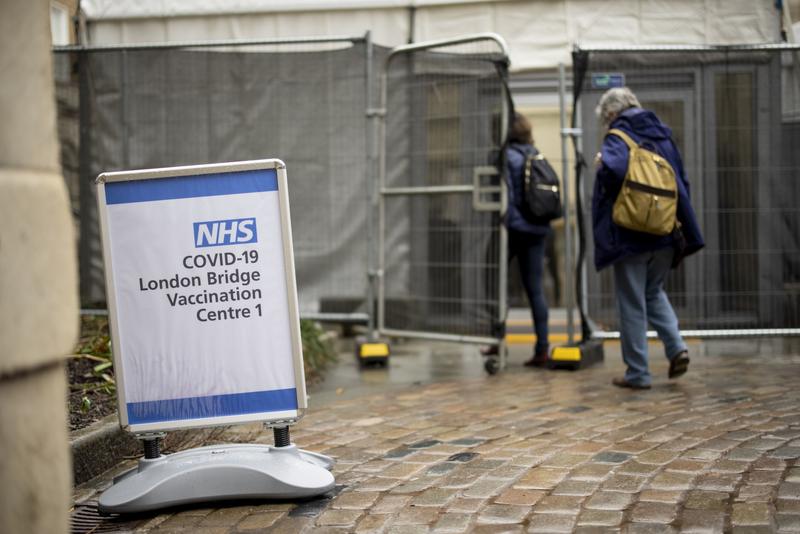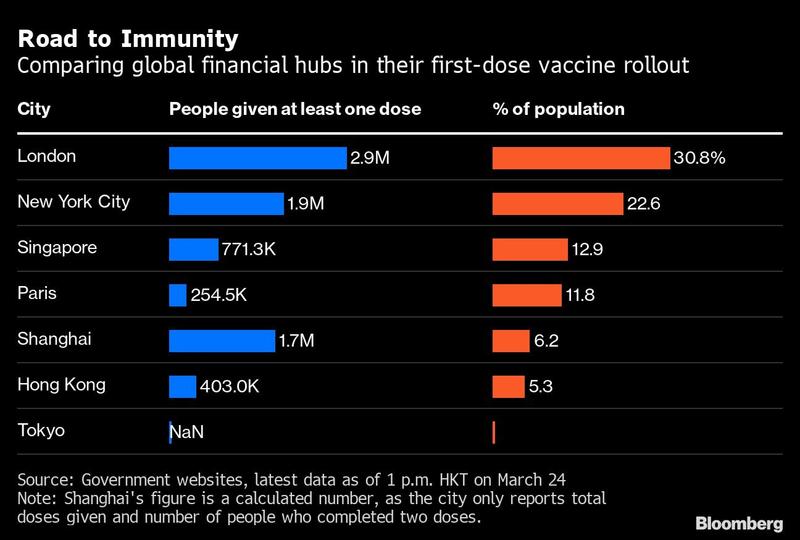 This undated photo shows people entering a COVID-19 vaccination center in London earlier in February 2021. (JASON ALDEN / BLOOBMERG)
This undated photo shows people entering a COVID-19 vaccination center in London earlier in February 2021. (JASON ALDEN / BLOOBMERG)
The financial capitals hit hardest by COVID-19 are pulling ahead in the race to vaccinate their residents.
The vaccine race is of particular importance in competitive global financial centers that rely on the free flow of capital and international talent, and getting a substantial portion of their populations vaccinated is the only way to get back to normal
London has outpaced global peers when measured by the percentage of residents inoculated with at least one dose, while Asian hubs like Hong Kong and Tokyo that recorded fewer infections are lagging far behind, according to the latest data available from each city’s government as of March 24.
The UK’s capital had covered roughly 2.9 million people - about 30 percent of its population - with one dose. That’s compared to 23 percent of residents who had received their first doses in New York City, 13 percent in Singapore and 12 percent in Paris.
London’s higher rate has been fueled in part by a strategy of draining its entire initial vaccine supply on the first round, and waiting for more batches before giving people their second shots.
ALSO READ: Vaccines should be made global common good
However, New York City topped London in another key metric: It has fully inoculated more people, completing vaccination courses for 11 percent of its population compared to just 2.3 percent of London’s residents. The US city began administering Johnson & Johnson’s single-dose vaccine earlier this month.

The vaccine race is of particular importance in competitive global financial centers that rely on the free flow of capital and international talent, and getting a substantial portion of their populations vaccinated is the only way to get back to normal.
While many pandemic hot spots like the US and UK are working to inoculate people as quickly as possible, governments in Asia-Pacific and some parts of Europe are dealing with widespread hesitation after reports of serious side effects and deaths - no more so than in Hong Kong, where only 5.3 percent of the population have come forward for a shot. The special adminstrative region has also temporarily suspended BioNTech SE’s vaccines after packaging defects were found.
READ MORE: Fosun, BioNTech find no vaccine safety concerns in initial probe
 Staff personnel assist people outside a closed community vaccination center administering the BioNTech COVID-19 vaccine imported by Fosun Pharma in Hong Kong, March 24, 2021, after the vaccine was temporarily suspended. (PHOTO / BLOOMBERG)
Staff personnel assist people outside a closed community vaccination center administering the BioNTech COVID-19 vaccine imported by Fosun Pharma in Hong Kong, March 24, 2021, after the vaccine was temporarily suspended. (PHOTO / BLOOMBERG)
The Chinese mainland's financial center Shanghai, which has largely contained the pandemic, has vaccinated 6.2 percent of its populations with at least one dose. The lower percentage must take into account Shanghai’s population of more than 24 million, which dwarfs those of London, Paris and New York. The mainland, which has largely contained the virus, has said it aims to inoculate 40 percent of its population before the end of June.
Tokyo’s tally reflects the fact that Japan hasn’t yet begun widespread vaccinations, even as the city prepares to host the COVID-delayed Summer Olympics. Japan is currently limiting vaccines to health-care workers and plans to inoculate the general public, starting with those 65 or older, in mid-April. So far, less than 1 percent of the country’s population has received a first dose.


